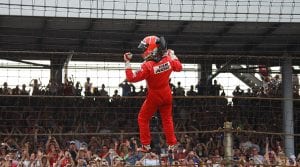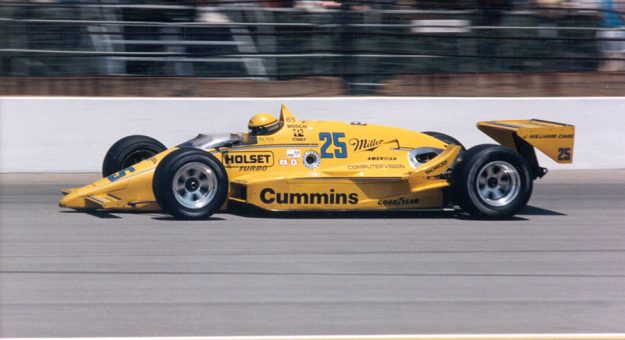The stunning victory made Unser the second four-time Indy 500 winner. It was 17 years between Unser’s first Indy triumph in 1970 and his fourth in 1987.
Four years later, Mears became the third four-time winner.
“There were two factors with Rick — his ability plus the fact he drove for Roger Penske,” Mario Andretti said. “If you ever want to win Indianapolis and have a shot at it, when you are driving for Roger Penske, you are in pretty good shape. Roger has to take a lot of credit for that.
“He (Mears) took advantage of the type of equipment he had under him and to me that, that makes him a very smart dude. He knew what to do with that.”
Mears wholeheartedly agrees with Andretti’s assessment that Team Penske provided everything necessary to become an Indy 500 legend.
“I put that down to the team,” Mears said. “I was so fortunate to get hooked up with Team Penske as early as I did in my career. Being with the best team in the business and them always giving me the tools that I needed to get the job done was the main key. That team and the equipment they gave me created any numbers that I have.
“It was because of them that I was able to accomplish what I did in that time frame.”
Andretti never had the chance to become a four-time winner at Indy. The legendary driver was beset by a streak of adversity at Indy that is one of the most remarkable stories in the history of the race.
One of the drivers Foyt, Unser and Mears had to beat to win four Indy 500s was Andretti.
“My career is richer by the fact I was able to drive against those dudes,” Andretti said. “They are as good as you could possibly have for adversaries. I got my licks in with them. That’s all you could ask for. The fact we were on the race track together gives me so much pleasure when I look back and see how fortunate that I had those opportunities.”
Eight years after Mears retired, he began working with a young Brazilian race driver who was an emergency hire after Greg Moore was killed during the final race of the 1999 CART season at Auto Club Speedway in Fontana, Calif.
Moore had been announced the previous day along with Gil de Ferran as the two Team Penske drivers for the 2000 season.
Castroneves earned his first victory in the 2000 CART race at Detroit’s Belle Isle. In 2001, Team Penske returned to the Indianapolis 500 for the first time since the split between Indy car racing factions in 1996.
Castroneves became an instant sensation. He is the only driver to take the checkered flag in his first two Indy 500s.
Castroneves drove in his final race for Team Penske in last year’s 104th Indianapolis 500. His 21-year tenure is the longest in Team Penske history.
This year’s race is the first Indy 500 in which the 45-year-old Castroneves will drive for another team.
“I’m blessed to have an era, to be honest,” Castroneves told SPEED SPORT. “But let’s see what the future holds and, hopefully, after this race we will be celebrating No. 4.
“The sky is the limit at Meyer Shank Racing. We have a great opportunity here. I don’t see anything to stop us from having great results and winning races.”

Montoya, also 45, will seek his third Indy victory driving for Arrow McLaren SP.
“I’m not big into history and all of that but winning it with McLaren would be pretty damn special,” Montoya told SPEED SPORT. “Everybody at Arrow McLaren SP has been working very hard over the past few years. They have a really good program. Pato O’Ward and Felix Rosenqvist are two young guys who have a lot of talent. I’ve had a lot of fun working with them already.
“I’m really excited to spend the month of May with them and help them as well. There are a lot of things that I know over the years that I can help.
“Felix is a little more quiet. Pato wants to know everything. That’s good,” Montoya added. “One of the things I’ve learned over the years is I don’t mind telling people everything because I still believe I can do a better job than them. If they can do a better job than me, then fair enough.
“The reason I’m here is because people still believe I can still get the job done.”
Sato was born in 1977, the year Foyt became the first four-time Indy winner. With his second Indy 500 victory last August, Sato is one of 20 drivers to win the Indianapolis 500 more than once. He is also the only Japanese winner of the Memorial Day weekend classic.
“When you think of the history, it’s incredible,” Sato said. “Certainly, last year’s win gives me a great opportunity to go for four if the opportunities allow me to. Hopefully, I will have a great car again in 2021.
“I love this place and I would love to continue the challenge. There is no reason why we can’t win it again this year.”
Of those three drivers, Sato has been the most impressive of late.
“The guy has a ‘pair’ on him and that doesn’t hurt,” Mario Andretti said. “To be able to do your job at Indy, you have to have a pretty solid pair of balls.”
Thirty years ago, Mears celebrated his fourth Indy 500 win in a tumultuous victory lane at Indianapolis Motor Speedway. It was his most satisfying of all four Indy 500 wins because of the shootout to the finish with Michael Andretti.
It was beyond Mears’ wildest dreams.
“It was hard to believe,” Mears recalled. “I said I never dreamed of even being there, let alone of racing there, let alone winning there. I never dreamed of being there and when I got the opportunity to run, it was a fairytale story. Then, once I even started running Indy cars and went to try to qualify at Indy, I never dreamed of driving for Roger, the best team in the business. That was a fairytale story when that happened.
“Those fairytale stories kept happening,” he added. “To get that fourth win, like I said after the third, what are the odds getting the fourth? And here I was with two of my heroes, A.J. and Al, being in their category, it was just so hard to believe.
“I never did feel like I was in their category, even though I had the fourth Indy 500 victory.”
